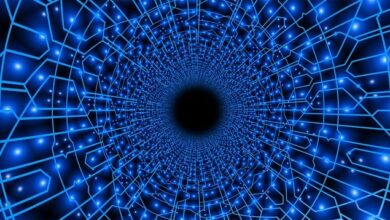Quantum Machine Learning: Unlocking the Power of Quantum Computers

Have you ever wondered about the secrets hidden within the quantum realm? Well, get ready to be amazed because quantum machine learning is here to unveil the untapped potential of quantum computers. In this article, we will explore how quantum machine learning is revolutionizing the world of artificial intelligence and opening doors to unprecedented possibilities.
But first, let’s understand what quantum machine learning really means. At its core, it combines the principles of quantum physics with the computational prowess of machine learning algorithms. It harnesses the immense power of quantum computers to perform complex computations and extract valuable insights from vast amounts of data.
In traditional computing, information is processed using bits that represent either a 0 or a 1. However, quantum computers leverage “qubits,” which can exist as both 0 and 1 simultaneously due to a phenomenon known as superposition. This unique property allows quantum computers to tackle highly intricate calculations more efficiently than classical computers.
So, how does quantum machine learning work? One of the key applications is in optimization problems. Quantum algorithms, such as the renowned Quantum Support Vector Machine (QSVM), can efficiently solve optimization tasks by leveraging the inherent parallelism of quantum computation. This opens up new avenues for solving complex optimization challenges in various fields like finance, logistics, and drug discovery.
Furthermore, quantum machine learning holds promise in enhancing pattern recognition. Quantum neural networks, inspired by their classical counterparts, utilize qubits to encode and process data. These networks have the potential to outperform classical deep learning models in terms of speed and accuracy, paving the way for advancements in image and speech recognition, natural language processing, and more.
The implications of quantum machine learning extend beyond specific applications. As researchers delve deeper into this field, they uncover new algorithms and methodologies that could potentially transform our understanding of computation itself. Quantum machine learning introduces us to a new era where machines can learn and adapt using the principles of quantum mechanics, leading to groundbreaking discoveries and innovations.
Quantum machine learning stands as a testament to human ingenuity and our relentless pursuit of knowledge. By harnessing the power of quantum computers, this emerging field has the potential to unlock new frontiers in artificial intelligence, optimization, pattern recognition, and beyond. As we venture further into the quantum realm, we are on the cusp of witnessing remarkable advancements that will shape the future of technology and propel us into an era of limitless possibilities.
Quantum Machine Learning: Revolutionizing Data Processing with Quantum Computers
Are you ready for the next revolutionary leap in data processing? Brace yourself, because quantum machine learning is here to transform the way we analyze and process information. Imagine a world where computers harness the mind-boggling power of quantum mechanics to solve complex problems faster and more efficiently than ever before. That’s the promise of quantum machine learning.

So, what exactly is quantum machine learning? It’s the marriage of two cutting-edge technologies: quantum computing and machine learning. Quantum computing utilizes the principles of quantum mechanics, which allow quantum bits, or qubits, to exist in multiple states simultaneously. This enables quantum computers to perform incredibly complex calculations in parallel, leading to exponential speedups over classical computers.

Now, combine this quantum computing power with the capabilities of machine learning. Machine learning algorithms are designed to learn and improve from data, making them ideal for tasks such as pattern recognition, optimization, and predictions. By applying machine learning techniques to quantum computers, we can leverage their immense computational prowess to tackle complex data processing challenges.
The impact of quantum machine learning can be felt across various fields. In healthcare, it can revolutionize drug discovery by rapidly analyzing vast amounts of molecular data, identifying potential treatments, and optimizing drug formulations. In finance, it can enhance fraud detection by sifting through massive transaction datasets to identify patterns indicative of fraudulent activities. And in cybersecurity, it can bolster threat detection systems by quickly detecting anomalies and adapting to evolving attack strategies.
But how does quantum machine learning work in practice? Traditional machine learning algorithms are adapted to run on quantum computers, taking advantage of their unique properties. These algorithms leverage quantum features such as superposition, entanglement, and interference to explore and exploit data in novel ways. By harnessing these quantum effects, quantum machine learning algorithms can potentially outperform classical counterparts, unlocking new possibilities in data analysis and prediction.
Quantum machine learning represents a paradigm shift in data processing. By harnessing the power of quantum computing and leveraging the capabilities of machine learning, we can tackle complex problems faster and more efficiently than ever before. The potential applications are vast and span across industries. As we delve deeper into this fascinating field, the boundaries of what we can achieve with data processing will expand, paving the way for a new era of discovery and innovation.
Unleashing Quantum Potential: How Quantum Machine Learning is Transforming AI
Have you ever wondered about the extraordinary capabilities of quantum computing and how it could revolutionize the field of artificial intelligence (AI)? Well, get ready to be amazed as we dive into the world of quantum machine learning and explore how it is transforming the landscape of AI.

Quantum machine learning combines the power of quantum computing with the principles of machine learning to create a formidable force in the realm of data analysis and decision-making. Traditional machine learning algorithms rely on classical computers to process and analyze vast amounts of data. However, these classical systems can struggle when faced with complex problems due to their inherent limitations.
This is where quantum machine learning steps in. By harnessing the peculiar properties of quantum mechanics, such as superposition and entanglement, quantum computers have the potential to exponentially speed up certain computations. This opens up new avenues for tackling intricate AI challenges that were previously beyond the reach of classical methods.
One of the most promising applications of quantum machine learning lies in optimization problems. Optimization plays a crucial role in various fields, from logistics and finance to drug discovery and energy management. Quantum algorithms, such as the Quantum Approximate Optimization Algorithm (QAOA), offer the promise of efficiently solving complex optimization tasks, leading to enhanced efficiency and cost savings across industries.

Another area where quantum machine learning demonstrates its prowess is in pattern recognition. Quantum algorithms, such as the Quantum Support Vector Machine (QSVM), are designed to classify and identify patterns within large datasets more effectively than their classical counterparts. These advancements have far-reaching implications for image and speech recognition, natural language processing, and even medical diagnostics.
While quantum machine learning is still in its nascent stages, it holds tremendous potential for transforming AI. Researchers and organizations worldwide are actively exploring this exciting field, striving to unlock the full capabilities of quantum computers and push the boundaries of what is possible in machine learning.

The fusion of quantum computing and machine learning is paving the way for a new era of AI. By leveraging the unique properties of quantum mechanics, quantum machine learning promises to revolutionize optimization, pattern recognition, and many other domains. As we continue to unlock the quantum potential, we are poised to witness groundbreaking advancements that will shape the future of artificial intelligence.
Harnessing the Quantum Frontier: Advancements in Quantum Machine Learning
Have you ever wondered about the extraordinary possibilities that lie within the quantum realm? Brace yourself for a mind-bending journey as we delve into the captivating world of harnessing the Quantum Frontier. In this article, we will explore the groundbreaking advancements in Quantum Machine Learning and how they are revolutionizing the field.
Quantum Machine Learning (QML) is an emerging discipline at the intersection of quantum computing and machine learning. It combines the immense computational power of quantum systems with the ability to process and analyze vast amounts of data. This powerful synergy has the potential to unlock new frontiers in various domains, from drug discovery to financial modeling.
One of the key advantages of QML is its ability to process information in parallel through the magic of superposition. Traditional computers analyze data sequentially, one bit at a time, while quantum computers can process multiple states simultaneously. This parallelism allows for exponential speedup in certain computations, offering a quantum leap in processing capabilities.
Imagine training complex machine learning models at an unprecedented pace, solving optimization problems with unrivaled efficiency, or uncovering hidden patterns in massive datasets with lightning-fast algorithms. QML holds the promise to transform industries by accelerating scientific discovery and enhancing decision-making processes.
To harness the Quantum Frontier, researchers are developing quantum algorithms specifically designed to leverage the unique properties of quantum systems. These algorithms exploit quantum phenomena such as entanglement and interference to perform computations that were previously intractable. By tailoring machine learning algorithms to the quantum domain, scientists aim to tackle problems that were once considered insurmountable.
However, the Quantum Frontier is not without its challenges. Quantum systems are highly sensitive to noise and decoherence, which can introduce errors into computations. To overcome these obstacles, researchers are actively working on error correction techniques and developing robust qubits—the building blocks of quantum computation.
The fusion of quantum computing and machine learning is propelling us into uncharted territories. Harnessing the Quantum Frontier through advancements in Quantum Machine Learning holds immense potential for solving complex problems and driving innovation across various industries. As we continue to push the boundaries of what is possible, the future of technology looks incredibly exciting. Get ready to witness the astonishing power of quantum!
Quantum Leap in Computing: The Intersection of Quantum Technology and Machine Learning
Have you ever wondered what the future of computing holds? Brace yourself for a mind-boggling journey into the realm of quantum technology and machine learning. It’s a merging of two cutting-edge fields that is set to revolutionize how we process information and solve complex problems. In this article, we’ll delve into the intriguing details of the quantum leap in computing and explore the intersection of quantum technology and machine learning.
Imagine a world where computers can perform calculations at an unimaginable speed, far surpassing our current capabilities. That’s precisely what quantum technology aims to achieve. Unlike classical computers that use bits to store and process information, quantum computers utilize qubits, which can exist in multiple states simultaneously. This inherent property allows quantum computers to perform parallel computations, exponentially increasing computational power.
But how does machine learning fit into this quantum equation? Machine learning is the process by which computers learn patterns and make predictions without being explicitly programmed. By leveraging the power of quantum computing, machine learning algorithms can be enhanced to tackle even more complex and large-scale datasets.
The marriage of quantum technology and machine learning opens up new frontiers in various domains. For instance, in drug discovery, quantum machine learning algorithms can analyze vast molecular databases and identify potential drug candidates with high accuracy. This could significantly accelerate the development of life-saving medications.
Moreover, quantum machine learning has the potential to optimize transportation systems, financial markets, and weather forecasting. By harnessing the immense computational power of quantum computers, we can uncover hidden patterns and gain deeper insights into these complex systems.
However, it’s important to note that realizing the full potential of quantum machine learning is still a work in progress. Quantum computers are incredibly delicate and prone to errors caused by environmental factors and noise. Overcoming these challenges requires significant advancements in hardware, error correction, and algorithm design.
The fusion of quantum technology and machine learning presents an awe-inspiring vision of the future of computing. It promises unprecedented computational power and opens up a world of possibilities across various industries. While there are still hurdles to overcome, the quantum leap in computing holds the potential to reshape our world and unlock new realms of knowledge and innovation.




